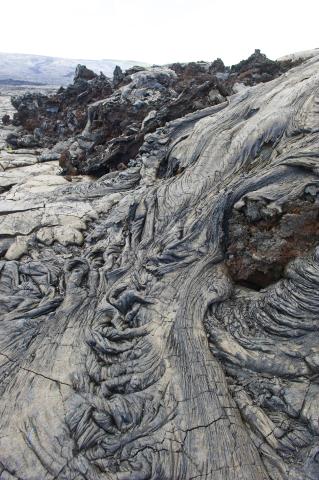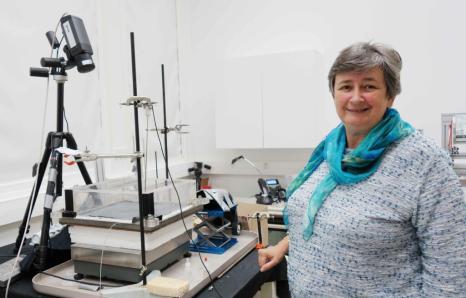
Anne Davaille: at the heart of planetary dynamics
Anne Davaille is CNRS Research Director at the Fluids, Automatics and Thermal Systems Laboratory (FAST - Université Paris-Saclay/CNRS).Trained as a physicist, she specialises in the study of complex fluids applied to the evolution of planetary cores. This unique expertise, at the crossroads of physics and planetology, has led to major discoveries and prestigious collaborations.
Anne Davaille has been fascinated by the secrets of the Earth's formation from an early age. As a child, she was fascinated by a lecture given by Maurice and Katia Kraft, famous French volcanologists: "My first contact with the theory of plate tectonics, which was still very new at the time,"she recalls. Three years later, this theory was confirmed by the Franco-American "FAMOUS" (French American Mid Ocean Underwater Survey) expedition to the Mid-Atlantic Rift.
Anne Davaille began studying physics, graduating in the late 1980s with an engineering degree from the École supérieure de physique et de chimie industrielles de la ville de Paris (ESPCI, Paris School of Industrial Physics and Chemistry) and a Master's degree in liquid physics from the Université Pierre et Marie Curie (now Sorbonne University). Then, led by her passion, she decided to complete a thesis "Straddling fluid mechanics and geophysics," under the supervision of Claude Jaupart at the Institut de Physique du Globe de Paris (IPGP, Paris Institute of Globe Physics). At the end of 1991, she moved to Yale University for post-doctorate studies. She then returned on numerous occasions over a period of eight years to carry out her experiments. In January 1993, Anne Davaille was recruited by the CNRS, and ten years later she became Director of Research, receiving her Accreditation to supervise research (HDR) in 2004.
A passion for telluric phenomena
Planet Earth holds numerous secrets. Its metallic core is surrounded by a thick rocky mantle and a thin layer of ocean and atmosphere. The evolution of a planet, born hot in a cold universe, took place by cooling, i.e. by the movements of its mantle: the warmer, lighter bottom of the mantle rose, while the colder, denser surface sank. This is known as thermal convection, the driving force behind plate tectonics. "The Earth's rocky mantle may be solid on our scale, but in fact it deforms at a speed comparable to that at which our fingernails grow. It's slow, but not that slow on the scale of a planet's billions of years," explains Anne Davaille.
Rocks have another peculiarity: they are much more rigid and brittle at a planet's cold surface than at depth. " Thus, instead of continuously deforming like honey, Mars' surface is immobile and very old, while the Earth's is cut into plates that form at ocean ridges, slide relative to each other (this is plate tectonics), before plunging back into the mantle (this is called subduction)." »
Far from being homogeneous, each plate is constantly evolving as a result of earthquakes and volcanic eruptions. But why does a plate break on Earth and not on Mars? " That's what we've been working on for the last fifteen years!" she answers. Anne Davaille collaborates with Christiane Alba-Simionesco, a physical chemist at the Laboratoire Léon Brillouin (LLB – Univ. Paris-Saclay/CEA/CNRS)and Hélène Massol, a planetologist at the Paris-Saclay Geosciences laboratory (GEOPS - Univ. Paris-Saclay/CNRS) to try and " understand how plate rheology depends on structure and history". ».
Research at the interface of several different sciences
Anne Davaille's research lies at the intersection of fluid mechanics and planetology. " Physicists think of me as a geophysicist and geophysicists as a physicist," she laughs. In 2008, she joined the Fluids, Automatics and Thermal Systems Laboratory (FAST - Université Paris-Saclay/CNRS)with the main aim of studying different convection regimes in complex fluids and understanding the dynamics of planetary interiors. The laboratory specialises in fluid flow, whether purely liquid or "soft matter" such as ketchup, hair gel and volcano lava. " These fluids behave either as solids or liquids, depending on the scale of time, stress and space at which they are observed." »
Unique expertise
« "I began by studying the convection of fluids whose viscosity depends to a great extent on temperature, such as sugar syrups, and then heterogeneous fluids. Once we have the physical understanding, the scaling laws based on laboratory experiments and theory, the aim is to substitute the laboratory parameters with data observed on planets, such as Venus, or on exoplanets, and thus predict their current regime, their heat balance and their evolution," explains Anne Davaille.
Her research has enabled her to identify new convection regimes and specific geometries, particularly in relation to the mantle plumes responsible for hotspot volcanism, such as in Hawaii and Reunion Island. These results, published in 1999 in a single-authored article in the journal Nature, later helped her and colleagues at IPGP to propose a classification of terrestrial hotspots.
Collaboration with NASA
Anne Davaille also studies other phenomena, such as subduction. How does she go about this? At FAST, together with her group she carries out experiments in colloids. By simulating both basal heating (generating plumes) and surface cooling, " I observed a regime where a plume triggers subduction around its impact zone. Although unlikely on Earth today, this observation found an unexpected echo at a conference in 2010." NASA's Susan Smrekar refers to similar structures observed on Venus, the "coronae", showing signs of both plumes and subduction. The two researchers began a collaboration that culminated in a joint publication in Nature Geosciencesin 2017. Following this, Anne Davaille became co-researcher of NASA's VERITAS mission, an orbiter scheduled to set off to map Venus in 2031. " My role is to model the physical processes inside the planet and provide an analytical framework for interpreting the new data. To do this, we need to carry out experiments, which our laboratory is the only one in the world to do, combining convection, complex rheology and observation of the surface signatures of deep-seated phenomena." »
Supported since 2009 by the INSU-CNRS-CNES National Planetology Programme and the ANR PTECTO project ANR PTECTO, then by LabEx PALM and various different European projects, Anne Davaille's work is currently being carried out as part of the SOFT-PLANET project (Convection and transfers in a partially molten textured planet, from the magmatic ocean stage to current solid-state convection), the winner of an ERC Advanced Grant starting in July 2023.
First honoured in 2019 with the Augustus Love Medal from the European Geosciences Union for her research in geodynamics, Anne Davaille was honoured a second time in 2020: she was named a Fellow of the American Geophysical Union.These two awards confirm the choices she has made: despite the obstacles, she has managed to reconcile family and professional life, and has embarked on daring research. Today, she hopes that her atypical and unique work will inspire younger generation of researchers.

